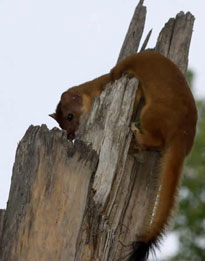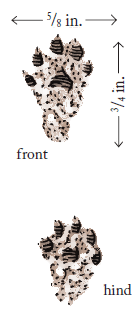Wildlife - Species

Species Specific Regulations
Long-Tailed Weasel
Licenses: Hunting License required.
Limits: Weapon restrictions according to game zones please check for Limitations.

Long-tailed weasel tracks
Long-Tailed Weasel (Mustela frenata)
Description
Weasels are long, slender animals with the typical short legs and low profile of mustelids. They are the smallest members of the family Mustelidae found in South Carolina, standing only 2 to 3 inches high at the shoulder. The fur is brown with white or yellow markings on the under parts. In the northern region of weasels' range, they have a white winter pelage. However, in South Carolina the summer and winter colors are similar.
Average Size
Males weigh 8 to 12 ounces, and females weigh only 3 to 8 ounces.
Life Expectancy
Approximately 5 years
Preferred Habitat
Weasels occupy a variety of habitats ranging from upland forest to bottomland swamps. They benefit from the “edge effect” that is created at the borders between woods and fields or along fence rows. They may be found in close proximity to man and have been known to raid hen houses.
Range
Long-tailed weasels are found in all 48 contiguous states, and scattered populations exist throughout South Carolina. Though weasels are not abundant anywhere in South Carolina, they are found more often in the Piedmont region than in the Coastal Plains.
Food Habits
Ounce for ounce, long-tailed weasels are the most aggressive and ferocious predators in South Carolina. The majority of their diet consists of mammals, some of which may be 2 or 3 times the body weight of the weasel. They are fond of rats, mice, moles, shrews, and cottontail rabbits. They also take a variety of small birds, eggs, insects, and occasionally poultry.
Reproduction
Peak Breeding Activity
Breeding in weasels occurs during the summer months. They are monogamous.
The young develop fast, and family breakup has usually occurred by late summer. Females may not reach sexual maturity until 1 year of age.
Gestation
Weasels, like other mustelids, exhibit delayed implantation of the fertilized egg, and therefore, the gestation period can last up to 275 days. Litter sizes average 4 to 7 young and are produced in the spring.
Miscellaneous:
Hawks, owls, foxes, bobcats, and dogs prey upon weasels. They are probably susceptible to the same diseases as other carnivores such as rabies and distemper.
Because of their low market value and sparse populations, a commercial harvest of long-tailed weasels does not exist in South Carolina. The weasel probably occurs undetected in some areas of the state because of its low numbers and its secretive nature. So few observations of weasels are made that its exact distribution in the state is not certain.
Publications and Literature
Baker, O.E., Carmichael, D. Breck, South Carolina Furbearers. Wildlife and Freshwater Fisheries Division. Columbia, South Carolina
Fur Harvest Hunting and Trapping are provided in the Fur Harvest Brochure which is a summary of the state statutes regarding the commercial harvest of furbearers. Applicable statutes are listed in parentheses at the end of each section of this brochure. Copies of actual statutes of the SC Code of Laws are available online from the SC Legislature at www.scstatehouse.gov or by writing: Furbearer Program, SC Department of Natural Resources, P.O. Box 167, Columbia, SC 29202.
Some of the files above are provided in the Adobe® Acrobat® (PDF) format. Adobe® Reader® is required to open these files and is available as a free download from the Adobe® Web site.
Jay Butfiloski - Furbearer Project Supervisor
SCDNR Furbearer Project
P. O. Box 167
Columbia, SC 29202-0167
Phone: 803-734-3886
Fax: 803-734-6020
E-mail: ButfiloskiJ@dnr.sc.gov

